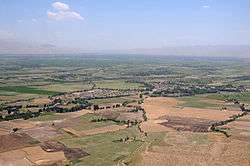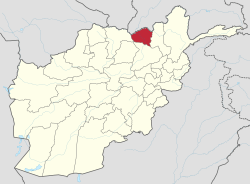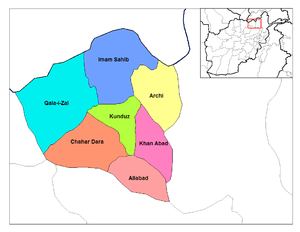Kunduz Province
Kunduz or Qunduz (Persian: قندوز, Pashto: کندوز) is one of the 34 provinces of Afghanistan, located in the northern part of the country next to Tajikistan. The population of the province is around 953,800,[2] which is mostly a tribal society; it is one of Afghanistan's most ethnically diverse provinces with many different ethnicities in large numbers living there.[3][4][5] The city of Kunduz serves as the capital of the province. It borders the provinces of Takhar, Baghlan, Samangan and Balkh. The Kunduz Airport is located next to the provincial capital.
Kunduz قندوز کندوز | |
|---|---|
 An aerial view from the window of a Blackhawk helicopter between Balkh Province and Kunduz Province | |
 Map of Afghanistan with Kunduz highlighted | |
| Coordinates (Capital): 36.8°N 68.8°E | |
| Country | |
| Capital | Kunduz |
| Government | |
| • Governor | Asadullah Omarkhail[1] |
| Area | |
| • Total | 8,040 km2 (3,100 sq mi) |
| Population (2012)[2] | |
| • Total | 953,800 |
| • Density | 120/km2 (310/sq mi) |
| Time zone | UTC+4:30 (Afghanistan Time) |
| ISO 3166 code | AF-KDZ |
| Main languages | Dari Pashto Uzbek Turkmen |
The Kunduz River valley dominates the Kunduz Province. The river flows irregularly from south to north into the Amu Darya river which forms the border between Afghanistan and Tajikistan. A newly constructed bridge crosses the Amu Darya at Sherkhan Bandar and the international trade is a large source of Kunduz's economy. The river, its tributaries, and derivative canals provide irrigation to the irrigated fields that dominate land usage in the agricultural province. There are also rain-fed fields and open range land that span several miles. Kunduz was once a major economic center for Afghanistan, but the wars since 1978 have changed fortunes for the province.[6]
History
The area has been part of many empires in the past. It became part of the Afghan Durrani Empire in the mid-18th century. It saw a major migration from Russian Turkestan in the north during the early 1920s. During the governance of Sher Khan Nasher, Kunduz became one of the wealthiest of Afghanistan's provinces, mainly due to Nasher's founding of the Spinzar Cotton Company, which continues to exist in post-war Afghanistan in the early 20th century.
Between one hundred and two-hundred thousand Tajiks and Uzbeks fled the conquest of their homeland by Russian Red Army and settled in northern Afghanistan.[7]
The province witnessed much violence and fighting during the Soviet-Afghan War.[8]
During the war in Afghanistan Kunduz was captured by NATO forces. In November 2001, members of the Taliban and Al-Qaeda, along with Pakistani military personnel and Afghan sympathizers were airlifted to Pakistan to evade NATO capture in the Kunduz Airlift.

Germany has 4000 soldiers stationed in the NATO-ISAF Kunduz province Provincial Reconstruction Team, along with Regional Command North. The province was largely peaceful until Taliban militants started infiltrating the area in 2009.[9]
On 4 September 2009, the German commander called in an American jet fighter, which attacked two NATO fuel trucks, which had been captured by insurgents. More than 90 people died, among them at least 40 civilians, who had gathered to collect fuel.[10][11]
It was reported that on 21 November 2009 a bomb going off along the Takhar Kunduz highway killed a child and injured two others.[12]
The governor, Mohammad Omar, was killed by a bomb on 8 October 2010.
On 10 February 2011, a suicide bomber killed a district governor and six other people in the district of Chardara in Kunduz Province, where the insurgency is well entrenched.[13]
Politics and governance
The current governor of Kunduz province is Asadullah Omarkhel.[14] The city of Kunduz is the capital of the province. All law enforcement activities throughout the province are controlled by the Afghan National Police (ANP). The Kunduz border with neighboring Tajikistan is monitored and protected by the Afghan Border Police (ABP), which is part of the ANP. A provincial police chief is assigned to lead both the ANP and ABP. The police chief represents the Ministry of the Interior in Kabul. The ANP is backed by other Afghan National Security Forces (ANSF), including the NATO-led forces.
According to the News reports, on 28 September 2015, Afghan Taliban has captured the Kunduz province.
Transportation
The province is served by Kunduz Airport which had regularly scheduled direct flights to Kabul as of May 2014. The Tajikistan–Afghanistan bridge at Panji Poyon connects the province to Tajikistan.
Economy
Agriculture and livestock husbandry are the primary occupations of the provinces residents. Fruit and vegetable are the most commonly farms items but there is also some cotton and sesame production.[15] Farmers faced water shortages.[16]
Men and women in Kunduz were employed in clothing production, metal working, carpentry and hide business.[16]
The port of Sherkhan Bandar provides an international outlet for Kunduz's goods and has allowed for importing commercial goods from Asia, Middle East, and the Persian Gulf.[16]
Healthcare
The percentage of households with clean drinking water fell from 25% in 2005 to 16% in 2011.[17] The percentage of births attended to by a skilled birth attendant increased from 6% in 2005 to 22% in 2011.[17]
Education
The overall literacy rate (6+ years of age) fell from 33% in 2005 to 20% in 2011.[17] The overall net enrolment rate (6–13 years of age) fell from 62% in 2005 to 50% in 2011.[17]
Demographics


Although a reliable census has not been carried out, the population of Kunduz province is estimated to be around 953,800.[2] The province is mostly rural and very ethnically diverse of Afghanistan's provinces.[18] According to the Naval Postgraduate School, the ethnic groups of the province are as follows: Tajik 33%; Uzbek 27%; Pashtun 22%; Turkmen 11%; Hazara 6%; and Pashai 1%.[3] Another source gives the following: Tajik 34%; Pashtun 20%; Uzbek 27%; Turkmen 9.4%; Arab 4.6%; and Hazara 3.5%; plus small groups of Pashayi, Baloch and Nuristani.[7]
About 94% of the population practice Sunni Islam and 6% are followers of Shia Islam.[3] The major languages spoken in the area are Pashto, Dari Persian, and Uzbeki.
Districts
| District | Capital | Population | Area[19] | Demographics[20] | |
|---|---|---|---|---|---|
| Ali Abad | 45,851 | 73% Tajik, 11% Pashtuns, 8% Hazara, 8% Uzbek [21] | |||
| Archi | 99,000 | 40% Pashtuns, 35% Uzbek, 15% Tajik, 10% Turkman | |||
| Chardara | 69251 | 35% Pashtuns, 25% Turkmen 25% Tajik, 15% Uzbek, | |||
| Imam Sahib | Sherkhan Bandar | 250,000 | 35% Turkmens 30% Uzbeks, 20% Pashtuns, 15% Tajiks, | ||
| Khan Abad | 110,000 | 40% Pashtuns, 25% Tajik, 20% Hazara, 10% Uzbek, 5% Pashai | |||
| Kunduz | Kunduz | 259,497 | 65% Tajik, 15% Pashtuns, 5% Turkmen,10% Uzbek, 10% Hazara | ||
| Qalay-I-Zal | 120,000 | 95% Turkmens, 5% Pashtuns |
References
- "Settled Population of Kunduz province by Civil Division, Urban, Rural and Sex-2012-13" (PDF). Islamic Republic of Afghanistan: Central Statistics Organization. Retrieved 17 January 2014.
- "Province: Kunduz" (PDF). Program for Culture & Conflict Studies. Naval Postgraduate School. Archived from the original (PDF) on 2 October 2012. Retrieved 17 January 2014.
- https://www.youtube.com/watch?v=72FA9HLBQls
- https://repository.upenn.edu/cgi/viewcontent.cgi?article=1012&context=senior_seminar
- https://www.youtube.com/watch?v=72FA9HLBQls
- Wörmer, Nils (2012). "The Networks of Kunduz: A History of Conflict and Their Actors, from 1992 to 2001" (PDF). Stiftung Wissenschaft und Politik. Afghanistan Analysts Network. p. 8. Retrieved 7 September 2013.
According to The Liaison Office the ethnic composition of Kunduz province is as follows: 34 per cent Tajik 27 per cent Uzbek, 20 per cent Pashtun, , 9.4 per cent Turkmen, 4.6 per cent Arab, 3.5 per cent Hazara, plus a few very small groups including Baluch, Pashai and Nuristani.
- https://repository.upenn.edu/cgi/viewcontent.cgi?article=1012&context=senior_seminar
- Bilal Sarwary (8 July 2001). "Taliban infiltrate once-peaceful Afghan north". BBC. Retrieved 5 September 2009.
- Scores dead in Nato raid on Kunduz. Al Jazeera English, September 2009
- Nato air strike in Afghanistan kills scores – The Guardian, 4 September 2009
- bombings kill 2 Afghan children, November 2009. Kabul, Xinhua news
- King, Laura (2 October 2011). "Afghanistan suicide bomber kills district governor, 6 others". Los Angeles Times. Retrieved 2 November 2011.
- http://www.thefrontierpost.com/article/373281//
- UN, 2003, http://afghanag.ucdavis.edu/country-info/Province-agriculture-profiles/unfr-reports/All-Kunduz.pdf
- Kunduz growers face irrigation water shortage, other pressing problems, By: Hidayatullah Hamdard ,Date: 2013-09-17, http://www.elections.pajhwok.com/en/content/kunduz-growers-face-irrigation-water-shortage-other-pressing-problems
- Archive, Civil Military Fusion Centre, https://www.cimicweb.org/AfghanistanProvincialMap/Pages/Kunduz.aspx Archived 2 September 2013 at Archive.today
- https://books.google.com/books?id=7pb-CwAAQBAJ&pg=PA86
- Afghanistan Geographic & Thematic Layers
- "Ethnic data taken from UNHCR Kunduz District Profiles on aims.org.af". Archived from the original on 31 May 2011. Retrieved 4 July 2009.
- Aliabad District, Kunduz Province. Afghan Biographies.
External links
| Wikimedia Commons has media related to Kunduz Province. |
